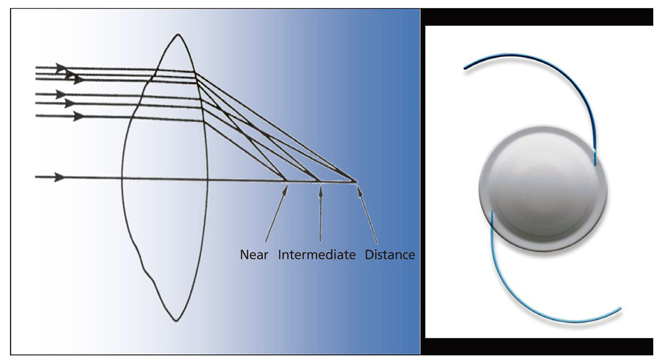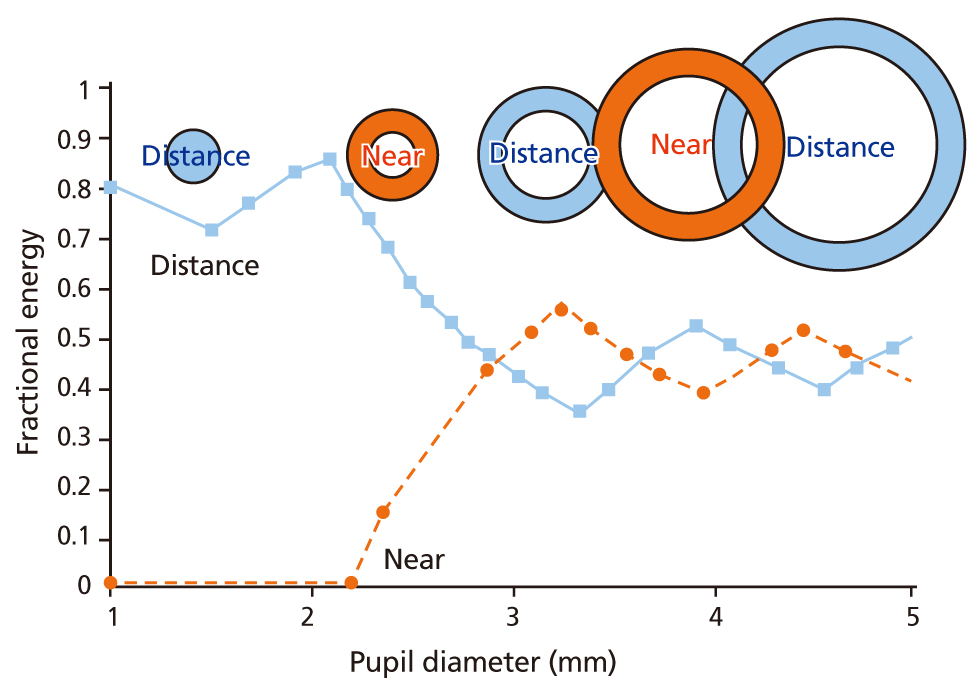J Korean Med Assoc.
2019 Oct;62(10):533-539. 10.5124/jkma.2019.62.10.533.
Clinical outcomes of currently available multifocal intraocular lenses
- Affiliations
-
- 1Department of Ophthalmology, Samsung Medical Center, Sungkyunkwan University School of Medicine, Seoul, Korea. tychung@skku.edu
- KMID: 2459929
- DOI: http://doi.org/10.5124/jkma.2019.62.10.533
Abstract
- This study investigates the characteristics and clinical outcomes of different types of extended depth-of-focus and multifocal intraocular lenses (IOLs) to determine which IOL can increase patient satisfaction. Modern cataract surgery has undergone tremendous evolution in terms of IOL quality. Recently, different types of presbyopia-correcting IOLs have become commercially available. Among them, multifocal IOLs are the most frequently used. Multifocal IOLs are different from conventional monofocal IOLs because these have multiple focus, which enable patients to see both distant and near objects at the same time. Multifocal IOLs can be classified as either refractive or diffractive IOLs. Diffractive multifocal IOLs include traditional bifocal lenses and relatively new trifocal lenses, and are the most widely used multifocal IOLs owing to their good clinical performance. Trifocal IOLs have an advantage over bifocal IOLs in terms of intermediate visual acuity, but can cause decreased contrast sensitivity and night vision disturbances. Recently developed extended depth-of-focus IOLs are different from traditional multifocal IOLs in that these extend the focus, resulting in smooth continuous focus. It also has the benefit of better contrast sensitivity and improved visual quality over multifocal IOLs; however, is relatively weak in terms of near visual acuity.
Keyword
MeSH Terms
Figure
Cited by 1 articles
-
Surgical treatment of presbyopia II
Eun Chul Kim
J Korean Med Assoc. 2019;62(12):623-628. doi: 10.5124/jkma.2019.62.12.623.
Reference
-
1. Akutsu H, Legge GD, Luebker A, Lindstrom RL, Zabel RW, Kirby VM. Multifocal intraocular lenses and glare. Optom Vis Sci. 1993; 70:487–495.
Article2. Davison JA, Simpson MJ. History and development of the apodized diffractive intraocular lens. J Cataract Refract Surg. 2006; 32:849–858.
Article3. Gunenc U, Celik L. Long-term experience with mixing and matching refractive array and diffractive CeeOn multifocal intraocular lenses. J Refract Surg. 2008; 24:233–242.
Article4. Bilbao-Calabuig R, Llovet-Rausell A, Ortega-Usobiaga J, Martinez-Del-Pozo M, Mayordomo-Cerda F, Segura-Albentosa C, Baviera J, Llovet-Osuna F. Visual outcomes following implantation of two diffractive trifocal intraocular lenses in 1084 eyes. Am J Ophthalmol. 2017; 179:55–66.
Article5. Bilbao-Calabuig R, Llovet-Osuna F, Gonzalez-Lopez F, Beltran J. Nd:YAG capsulotomy rates with two trifocal intraocular lenses. J Refract Surg. 2016; 32:748–752.
Article6. Hogarty DT, Russell DJ, Ward BM, Dewhurst N, Burt P. Comparing visual acuity, range of vision and spectacle independence in the extended range of vision and monofocal intraocular lens. Clin Exp Ophthalmol. 2018; 46:854–860.
Article7. Akella SS, Juthani VV. Extended depth of focus intraocular lenses for presbyopia. Curr Opin Ophthalmol. 2018; 29:318–322.
Article8. Bellucci R, Curatolo MC. A new extended depth of focus intraocular lens based on spherical aberration. J Refract Surg. 2017; 33:389–394.
Article9. Dominguez-Vincent A, Esteve-Taboada JJ, Del Aguila-Carrasco AJ, Ferrer-Blasco T, Montes-Mico R. In vitro optical quality comparison between the Mini WELL Ready progressive multifocal and the TECNIS Symfony. Graefes Arch Clin Exp Ophthalmol. 2016; 254:1387–1397.
Article10. Dominguez-Vincent A, Esteve-Taboada JJ, Del Aguila-Carrasco AJ, Monsalvez-Romin D, Montes-Mico R. In vitro optical quality comparison of 2 trifocal intraocular lenses and 1 progressive multifocal intraocular lens. J Cataract Refract Surg. 2016; 42:138–147.
Article11. Martinez de Cameros-Liorente A, Martinez de Cameros A, Martinez de Cameros-Liorente P, Jimenez-Alfaro I. Comparison of visual acuity and subjective outcomes among 3 trifocal intraocular lenses and 1 bifocal intraocular lens. J Cataract Refract Surg. 2019; 45:587–594.12. Ruiz-Mesa R, Abengozar-Vela A, Ruiz-Santos M. A comparative study of the visual outcomes between a new trifocal and extended depth of focus intraocular lens. Eur J Ophthalmol. 2018; 28:182–187.
Article
- Full Text Links
- Actions
-
Cited
- CITED
-
- Close
- Share
- Similar articles
-
- Clinical Outcomes after Exchange of Diffractive Multifocal Intraocular Lenses with Monofocal Intraocular Lenses
- Clinical Results of 3M Multifocal Intraocular Lens
- Clinical Efficacy of Bunny Multifocal Intraocular Lens after Cataract Surgery
- Surgical treatment of presbyopia II
- Pseudoaccomodation in Pseudophakic Eyes with 3M Multifocal Intraocular Lens







